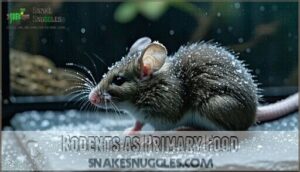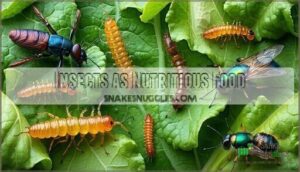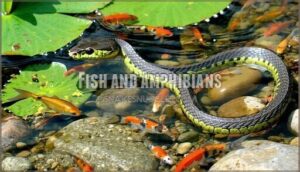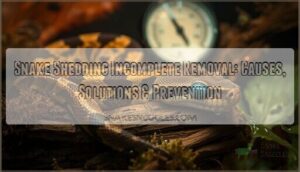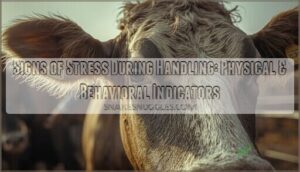This site is supported by our readers. We may earn a commission, at no cost to you, if you purchase through links.
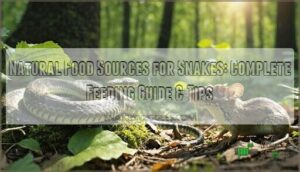
Birds, eggs, fish, frogs, and insects also provide essential nutrition. Different snake species have evolved to hunt specific prey – some specialize in amphibians while others prefer warm-blooded mammals.
The key is variety and proper size matching. Whole prey animals deliver complete nutrition including calcium from bones, unlike processed pet foods.
Young snakes typically eat more frequently than adults, with feeding schedules varying by species and size. Understanding these natural preferences helps snake owners replicate healthy diets, though there’s more to think about regarding prey preparation and feeding safety.
Table Of Contents
- Key Takeaways
- Snake Dietary Needs
- Feeding Snakes Naturally
- Snake Food Options
- Nutritional Balance
- Ecological Role
- Frequently Asked Questions (FAQs)
- What can snakes eat besides mice?
- How do you feed a snake a healthy diet?
- Can snakes eat fruits and vegetables?
- Are commercially available snake diets a good option?
- What do captive snakes eat?
- Can snakes eat alternative food?
- What can I feed my snake if I don’t have mice?
- What is the most nutritious food for snakes?
- What can I give my snake as a snack?
- Can snakes survive without eating live prey?
- Conclusion
Key Takeaways
- Feed whole prey animals like frozen-thawed rodents to provide complete nutrition with calcium from bones, vitamins from organs, and proper hydration – they’re far superior to processed alternatives
- Match prey size to your snake’s thickest body section (about 1.5 times the girth) and follow species-specific feeding schedules – juveniles need meals every 5-7 days while adults eat every 10-14 days
- Maintain a 2:1 calcium-to-phosphorus ratio through natural whole prey rather than supplements, and avoid overfeeding which can cause obesity and serious health problems
- You can diversify your snake’s diet with species-appropriate alternatives like birds, fish, insects, or eggs, but always research your specific snake’s natural prey preferences and nutritional needs
Snake Dietary Needs
Your snake’s health depends entirely on meeting its specific dietary needs through proper nutrition.
Understanding protein sources, vitamin D3 importance, fat requirements, and mineral supplementation guarantees your serpent thrives in captivity while mimicking its natural feeding patterns, which is crucial for its overall health.
Protein Sources
Understanding your snake’s protein needs starts with recognizing they’re obligate carnivores requiring animal-based nutrition.
Rodent nutrition forms the foundation, providing complete amino acid profiles through whole prey.
Insect protein works well for smaller species, while fish benefits include omega-3 fatty acids.
Egg protein offers easily digestible nutrition when fed moderately.
Commercial options like Reptilink analysis show balanced formulations, but natural snake prey animals remain ideal protein sources for peak health, providing a foundation for understanding the importance of complete amino acid profiles.
Vitamin D3 Importance
Vitamin D3 acts like your snake’s internal sunshine, helping absorb calcium for strong bones and preventing metabolic bone disease.
Your snake’s internal sunshine powers calcium absorption for unbreakable bones.
Without proper vitamin D3, your scaly friend can’t use dietary calcium effectively, leading to serious health problems.
- D3 Synthesis – Snakes produce vitamin D3 through UV exposure or receive it from whole prey items
- Supplement Dosage – Captive snakes may need careful vitamin D3 supplementation when UV lighting isn’t available
- Deficiency Symptoms – Watch for soft shells in eggs, bone deformities, and poor metabolic health as warning signs
Fat Requirements
While energy storage might seem straightforward, fat requirements for snakes go beyond simple fuel.
Your snake needs dietary fats for organ function, hormone production, and insulation.
These fatty acids support essential processes that keep your pet healthy and thriving.
| Fat Function | Benefit |
|---|---|
| Energy Storage | Provides long-term fuel between meals |
| Organ Function | Supports kidney and liver health |
| Hormone Production | Enables reproduction and growth |
| Insulation | Maintains body temperature regulation |
| Nutrient Absorption | Helps process fat-soluble vitamins |
The benefits of these fatty acids include hormone production, which enables reproduction and growth, as well as maintaining body temperature regulation through insulation.
Mineral Supplementation
Beyond fats, your snake needs proper mineral supplementation to thrive.
Zinc benefits immune function while preventing common deficiencies that weaken your pet’s defenses.
Iron deficiency can lead to anemia, making supplementation essential for healthy blood.
The calcium to phosphorus ratio should stay at 2:1 for strong bones.
Calcium sources from whole prey typically provide adequate minerals, though vitamin D3 helps absorption when needed.
Feeding Snakes Naturally
When you choose to feed your snake naturally, you’re mimicking their wild diet with whole prey items that provide complete nutrition.
This approach offers better health outcomes than processed alternatives, giving your snake the calcium from bones, vitamins from organs, and proper hydration from fresh tissues, which leads to better health outcomes.
Whole Prey Benefits
You’ll give your snake the ultimate nutrition package when you feed wholeprey items.
These complete meals deliver nutrient completeness through bone consumption for calcium, organ richness packed with vitamins, and natural hydration from blood and tissues.
Balanced nutrition comes naturally – no guesswork needed.
This feeding approach provides mental enrichment too, letting your snake experience natural prey-handling behaviors that keep them engaged and healthy.
To guarantee safety, always use frozen-thawed rodents instead of live prey.
Feeding Frequency
Your snake’s feeding schedule depends heavily on age and species.
Juvenile meals occur every 5-7 days since growing snakes need consistent nutrition, while adult schedules stretch to 10-14 days between feedings.
Species variation matters substantially – ball pythons naturally eat less frequently than corn snakes.
- Age-based timing: Young snakes require twice-weekly meals for proper development
- Species-specific needs: Research your snake’s natural feeding patterns and metabolism
- Seasonal changes: Some species eat less during cooler months or breeding seasons
Monitor your snake’s body condition and adjust feeding frequency accordingly.
Overfeeding causes obesity, while underfeeding stunts growth.
Prey Selection
Choosing appropriate snake prey animals requires matching prey size to your snake’s girth—typically 1.5 times the snake’s thickest point.
Consider your snake’s natural hunting strategies when selecting snake food sources. Venomous species benefit from pre-killed prey to maintain venom efficacy, while constrictors can handle live options.
Seasonal variation affects snake preferred prey availability, so stock frozen alternatives. Your snake’s habitat influence determines whether they prefer rodents, birds, or fish-based snake food options.
Snake Food Options
When you’re choosing food for your snake, understanding the variety of natural prey options helps you provide proper nutrition that mimics what they’d eat in the wild.
From rodents and birds to insects and fish, each food type offers unique nutritional benefits that support your snake’s health and natural feeding behaviors, including proper nutrition and natural feeding.
Rodents as Primary Food
Mice and rats form the backbone of most captive snake diets.
You’ll find frozenthawed mice safer than live prey, eliminating injury risks.
Rodent size matters – your snake’s meal should match its thickest body section.
Proper rodent gut loading enhances nutrition before feeding.
Ethical rodent sourcing guarantees quality prey while preventing obesity risk through controlled portions.
Many keepers find a reliable source for pre-killed snake food, which is essential for a healthy diet.
Alternative Prey Items
Beyond rodents, you’ll find plenty of alternatives to diversify your snake’s menu.
Birds like quail chicks offer richer textures, while safe fish species provide omega-3s for aquatic snake breeds.
Egg supplementation works well occasionally, though it shouldn’t replace whole prey.
Commercial diets and Reptilinks combine multiple protein sources conveniently.
For smaller species, insects require proper gut-loading before feeding.
These alternative food sources prevent nutritional gaps while mimicking wild feeding patterns your snake would naturally encounter.
It’s also important to bear in mind ethical prey sourcing for your snake’s diet.
Insects as Nutritious Food
Bugs aren’t just backyard pests—they’re powerhouse nutrition for smaller snake species. Crickets, mealworms, and silkworms pack impressive insect protein levels, with silkworms reaching 63% protein content. Gut loading these critters with nutritious foods boosts their mineral content before feeding.
Top Insect Options for Snake Dietary Needs:
- Black soldier fly larvae – Superior calcium-to-phosphorus ratio at 1.5:1
- Silkworms – Highest protein content at 63% with lower fat
- Crickets – Readily available with good protein around 17-19%
- Mealworms – Consistent 16% protein, perfect for regular feeding
Proper insect sourcing matters since wild-caught bugs may carry parasites. Your insectivorous snake food becomes more nutritious when insects are gut-loaded 24 hours before feeding. To maximize nutritional benefits, consider advanced gut loading for your feeder insects. This process enhances digestive enzymes and creates nutritious snake food that mimics natural prey.
Fish and Amphibians
Several aquatic prey species offer nutritional diversity for water snakes and amphibian diet snakes.
Fish provide excellent protein but carry thiaminase risks that destroy vitamin B1, potentially causing neurological issues.
Choose thiaminase-free options like trout or silversides while avoiding goldfish.
Safe amphibians include frogs and salamanders, though fish parasites remain concerns with wild-caught prey.
Always source cleaned, parasite-free aquatic prey for ideal fish nutrition.
Some snakes may also benefit from non live food options.
Nutritional Balance
Getting the nutritional balance right means understanding your snake’s specific needs for minerals, vitamins, and hydration.
You’ll need to monitor calcium-to-phosphorus ratios, watch for signs of overfeeding, and track your snake’s overall health through regular observation of weight and behavior.
Calcium to Phosphorus Ratio
Your snake’s calcium to phosphorus ratio directly impacts bone health and overall wellness.
The ideal ratio stands at 2:1, meaning twice as much calcium as phosphorus, which is crucial for balanced reptile nutrition.
Whole prey naturally provides this balance, while insects often fall short at 0.33:1.
Species variation affects requirements – juveniles need higher ratios for growth, and understanding these needs is key to preventing issues like organ damage from excess calcium.
Supplementation risks include organ damage from excess calcium, so stick to proper dietary sources for balanced reptile nutrition.
Importance of Hydration
Water works like magic for snakes’ health.
Your snake gets most hydration through prey moisture from blood and tissues, not drinking habits like mammals.
Proper environmental humidity supports shedding hydration and organ function.
Natural food sources containing adequate moisture meet snake nutritional requirements better than dry alternatives, ensuring your snake’s diet provides essential hydration for ideal health.
Ensuring adequate live prey moisture is essential for a snake’s well-being.
Avoiding Overfeeding
Overfeeding poses serious health risks to your snake, potentially causing obesity and shortened lifespan.
Proper portion control means matching prey size to your snake’s thickest body section. Establish consistent feeding schedules based on your pet’s age and species.
Weight monitoring helps you catch problems early. Adult snakes typically need meals every 10-14 days, while juveniles require more frequent snake feeding.
One common issue is improper prey thawing, which can lead to health complications. Adjust feeding frequency if weight gain becomes excessive to prevent serious health issues, ensuring a long and healthy life for your pet.
Monitoring Snake Health
Regular weight monitoring reveals changes in your snake’s body condition before problems become serious.
Check for proper muscle tone along the spine and watch for unusual behavior changes like refusing food or increased aggression.
Healthy skin sheds cleanly without retained pieces, while dull or patchy skin signals nutritional issues.
Schedule veterinary checkups annually to catch health problems early.
Make dietary adjustments based on your vet’s recommendations and your snake’s changing needs, ensuring proper muscle tone and overall health, which can be indicated by healthy skin.
Ecological Role
You’ll discover how snakes serve as nature’s pest controllers, keeping rodent and insect populations balanced through their diverse hunting strategies.
Their role extends beyond predation—they’re both predators and prey, creating essential links in food webs that support healthy ecosystems across the globe, which is a key aspect of being nature’s pest controllers.
Snake Feeding Behaviors
Understanding wild snake feeding behavior helps you appreciate these remarkable predators’ survival strategies.
Their hunting instincts drive complex behavioral patterns that showcase nature’s efficiency.
Snakes use three main predatory techniques based on their sensory adaptations:
- Ambush predators like vipers rely on camouflage and patience
- Active hunters such as racers pursue prey using speed
- Constrictors suffocate victims through powerful coiling
These snake hunting techniques demonstrate metabolic efficiency, allowing them to survive weeks between meals while maintaining peak performance.
Captive snakes, however, require careful attention to prey size considerations for ideal health.
Prey Types and Diversity
Snakes showcase remarkable prey diversity across species, adapting their hunting strategies to capture everything from tiny insects to large mammals.
Wild diets vary dramatically—garter snakes target earthworms and fish, while pythons pursue birds and rodents.
Prey size directly influences snake growth and health, and in captivity, you’ll need species-specific prey sourcing that mimics natural snake diet patterns, ensuring your pet receives appropriate nutritional variety.
Controlling Populations
From frogs to rodents, a snake’s natural diet keeps wild prey numbers in check.
Your local garter or rat snake might munch on pests, acting as nature’s pest control.
This predator impact helps regulate prey populations, supporting ecosystem health.
By understanding snake feeding habits and the food web, you’ll see how species interaction shapes a balanced snake food list.
Maintaining Ecological Balance
Beyond prey populations, you’re witnessing nature’s intricate web at work.
Wild snake prey availability directly influences ecosystem health through predator control mechanisms.
When snake food availability decreases, biodiversity impact ripples through entire habitats.
Conservation efforts now recognize how snake diet diversity maintains ecological balance.
- Snake prey habitat preservation protects multiple species simultaneously
- Predator control prevents rodent overpopulation and crop damage
- Biodiversity impact extends from soil health to forest regeneration
This delicate balance keeps ecosystems thriving naturally, maintaining predator control mechanisms.
Frequently Asked Questions (FAQs)
What can snakes eat besides mice?
You’ll find rats, chicks, quail eggs, and fish work well for most species. Garter snakes enjoy earthworms and insects, while larger constrictors thrive on rabbits or guinea pigs when appropriate.
How do you feed a snake a healthy diet?
Feed your snake whole prey items like frozen-thawed rodents, matching prey size to your snake’s width.
Offer meals every 5-14 days depending on age and species, maintaining proper calcium-to-phosphorus ratios for ideal health.
Can snakes eat fruits and vegetables?
Like a locked door that won’t budge, snakes can’t digest fruits and vegetables. You shouldn’t offer plant matter since they’re obligate carnivores requiring only animal-based nutrition for proper health.
Are commercially available snake diets a good option?
Commercially available snake diets offer convenience and expert formulation, but they shouldn’t replace whole prey entirely.
You’ll find pellets, powders, and canned options that provide balanced nutrition when used properly alongside traditional feeding methods.
What do captive snakes eat?
Roughly 95% of captive snakes eat frozen-thawed rodents as their primary food source.
You’ll typically feed your snake mice or rats, with juveniles eating every 5-7 days and adults every 10-14 days, depending on species.
Can snakes eat alternative food?
Yes, you can feed snakes alternative foods beyond traditional rodents. Fish, eggs, chicks, insects, and commercial snake diets work well when nutritionally balanced and species-appropriate.
What can I feed my snake if I don’t have mice?
Ironically, you’ve got more options than you might think.
Try frozen-thawed rats, chicks, quail, or commercial snake sausages.
Fish works for some species, but avoid thiaminase-rich varieties.
Always make certain of proper size and nutritional balance.
What is the most nutritious food for snakes?
Whole prey animals like rats and mice provide complete nutrition for your snake.
They contain balanced protein, calcium from bones, essential vitamins from organs, and proper fat ratios that support healthy growth and development.
What can I give my snake as a snack?
Snakes are absolutely carnivorous creatures who don’t need traditional "snacks"! Instead, you can occasionally offer quail eggs, small fish like silversides, or appropriately-sized chicks between regular meals for enrichment.
Can snakes survive without eating live prey?
Your snake can thrive on frozen-thawed prey, which eliminates live feeding risks.
Commercial diets, whole fish, eggs, and insects provide complete nutrition when properly balanced, making live prey unnecessary for healthy captive snakes.
Conclusion
Mastering natural food sources for snakes isn’t rocket science, but it’s absolutely essential for your pet’s health.
You’ll need to match prey size to your snake’s girth, maintain proper calcium-phosphorus ratios, and stick to species-appropriate feeding schedules.
Whether you’re offering rodents, birds, or insects, whole prey provides complete nutrition that processed foods can’t match.
Monitor your snake’s body condition regularly and adjust feeding frequency as needed, to keep your serpent thriving for years to come with consistent attention.
- https://www.ultimatekilimanjaro.com/what-do-snakes-eat/
- https://roanoke.aaacwildliferemoval.com/blog/snakes/what-do-snakes-eat/
- https://a-z-animals.com/animals/snake/snake-facts/snakes-that-can-eat-a-human-2/
- https://www.crittercontrol.com/wildlife/snakes/snake-diet/
- https://www.oriannesociety.org/uncategorized/snake-diets-guide-species-native-southeast/


